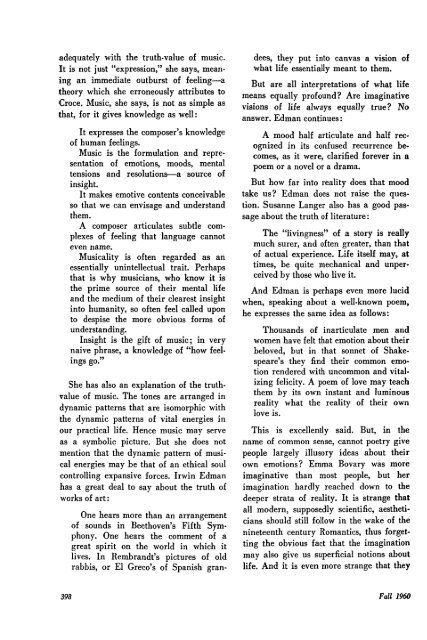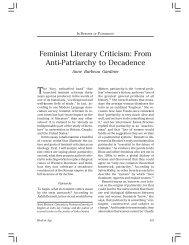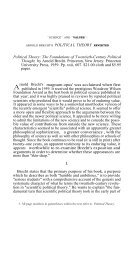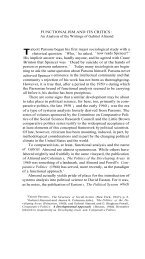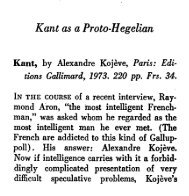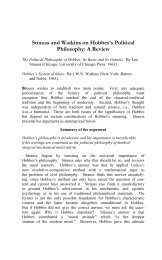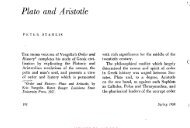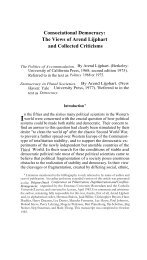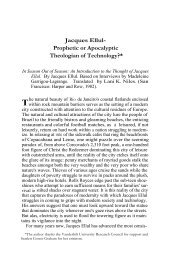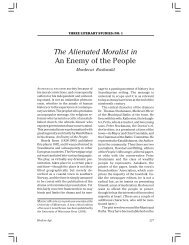Irving Babbitt the Aestheticians
Irving Babbitt the Aestheticians
Irving Babbitt the Aestheticians
Create successful ePaper yourself
Turn your PDF publications into a flip-book with our unique Google optimized e-Paper software.
adequately with <strong>the</strong> truth-value of music.<br />
It is not just “expression,” she says, mean-<br />
ing an immediate outburst of feeling-a<br />
<strong>the</strong>ory which she erroneously attributes to<br />
Croce. Music, she says, is not as simple as<br />
that, for it gives knowledge as well:<br />
It expresses <strong>the</strong> composer’s knowledge<br />
of human feelings.<br />
Music is <strong>the</strong> formulation and repre-<br />
sentation of emotions, moods, mental<br />
tensions and resolution-a source of<br />
insight.<br />
It makes emotive contents conceivable<br />
so that we can envisage and understand<br />
<strong>the</strong>m.<br />
A composer articulates subtle com-<br />
plexes of feeling that language cannot<br />
even name.<br />
Musicality is often regarded as an<br />
essentially unintellectual trait. Perhaps<br />
that is why musicians, who know it is<br />
<strong>the</strong> prime source of <strong>the</strong>ir mental life<br />
and <strong>the</strong> medium of <strong>the</strong>ir clearest insight<br />
into humanity, so often feel called upon<br />
to despise <strong>the</strong> more obvious forms of<br />
understanding.<br />
Insight is <strong>the</strong> gift of music; in very<br />
naive phrase, a knowledge of “how feel-<br />
ings go.”<br />
She has also an explanation of <strong>the</strong> truth-<br />
value of music. The tones are arranged in<br />
dynamic patterns that are isomorphic with<br />
<strong>the</strong> dynamic patterns of vital energies in<br />
our practical life. Hence music may serve<br />
as a symbolic picture. But she does not<br />
mention that <strong>the</strong> dynamic pattern of musi-<br />
cal energies may be that of an ethical soul<br />
controlling expansive forces. Irwin Edman<br />
has a great deal to say about <strong>the</strong> truth of<br />
dees, <strong>the</strong>y put into canvas a vision of<br />
what life essentially meant to <strong>the</strong>m.<br />
But are all interpretations of what life<br />
means equally profound? Are imaginative<br />
visions of life always equally true? No<br />
answer. Edman continues:<br />
A mood half articulate and half rec-<br />
ognized in its confused recurrence be-<br />
comes, as it were, clarified forever in a<br />
poem or a novel or a drama.<br />
But how far into reality does that mood<br />
take us? Edman does not raise <strong>the</strong> ques-<br />
tion. Susanne Langer also has a good pas-<br />
sage about <strong>the</strong> truth of literature:<br />
The “livingness” of a story is really<br />
much surer, and often greater, than that<br />
of actual experience. Life itself may, at<br />
times, be quite mechanical and unper-<br />
ceived by those who live it.<br />
And Edman is perhaps even more lucid<br />
when, speaking about a well-known poem,<br />
he expresses <strong>the</strong> same idea as follows:<br />
Thousands of inarticulate men and<br />
women have felt that emotion about <strong>the</strong>ir<br />
beloved, but in that sonnet of Shake-<br />
speare’s <strong>the</strong>y find <strong>the</strong>ir common emo-<br />
tion rendered with uncommon and vital-<br />
izing felicity. A poem of love may teach<br />
<strong>the</strong>m by its own instant and luminous<br />
reality what <strong>the</strong> reality of <strong>the</strong>ir own<br />
love is.<br />
This is excellently said. But, in <strong>the</strong><br />
name of common sense, cannot poetry give<br />
people largely illusory ideas about <strong>the</strong>ir<br />
own emotions? Emma Bovary was more<br />
imaginative than most people, but her<br />
imagination hardly reached down to <strong>the</strong><br />
works of art: deeper strata of reality. It is strange - that<br />
all modern, supposedly scientific, aes<strong>the</strong>ti-<br />
One hears more than an arrangement<br />
cians should still follow in <strong>the</strong> wake of <strong>the</strong><br />
of sounds in Beethoven’s Fifth Symphony.<br />
one hears he comment of a<br />
nineteenth century Romantics, thus forgetgreat<br />
spirit on <strong>the</strong> world in which it ting <strong>the</strong> obvious fact that <strong>the</strong> imagination<br />
lives. In Rembrandt’s pictures of old may also give US superficial notions about<br />
rabbis, or El Greco’s of Spanish gran- life. And it is even more strange that <strong>the</strong>y<br />
398 Fall 1960


